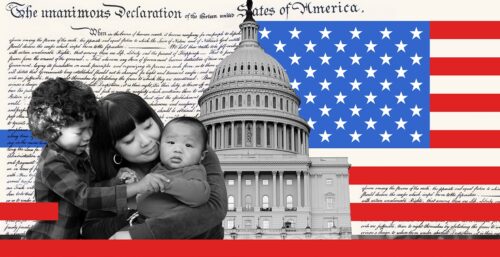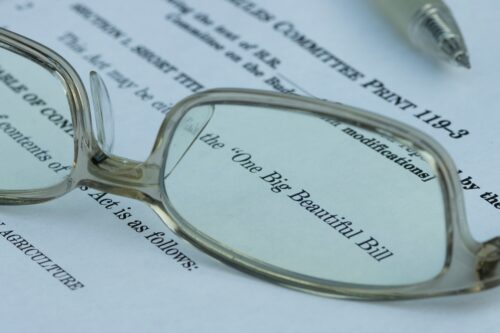Current immigration law allows certain undocumented immigrants to become Lawful Permanent Residents (LPRs) without first having to leave the United States. Under Section 245(i) of the Immigration and Nationality Act (INA), those undocumented immigrants who had an immigrant visa petition or labor certification application filed on their behalf on or before a specified date (filing deadline) are eligible to apply for LPR status without having to depart the United States, provided that they pay a fee and meet certain other conditions. The rules governing who can apply for adjustment of status under 245(i) have changed twice since the law was created in 1994. The last time this occurred was in 2000, when a deadline of April 30, 2001, was set for the filing of the necessary immigrant visa petition or labor certification application. This date is now so far in the past that it applies to very few of the undocumented immigrants currently residing in the country. However, Congress has the power to amend Section 245(i) again at any time. This could potentially make it available to hundreds of thousands of undocumented immigrants for whom immigrant visa petitions have already been filed by family members in the United States, but which have been languishing for years in the visa backlogs that plague the family-based immigration system.
History of 245(i)
Before 1994, noncitizens in the United States were generally ineligible to become LPRs if they had not been legally admitted or paroled, had not subsequently maintained lawful status (with some exceptions), or had worked without authorization. However, in 1994 Congress added a temporary subsection (i) to Section 245 of the INA that allowed certain undocumented immigrants to apply for and obtain LPR status from within the United States if they were eligible for an immediately available immigrant visa and paid a fee. Under this initial version of 245(i), a qualifying undocumented immigrant had to be eligible for—and apply for—adjustment of status before the law expired. Section 245(i) was set to take effect on October 1, 1994, and expire on October 1, 1997.
Section 245(i) became a particularly important option for many undocumented immigrants in 1996, when the Illegal Immigration Reform and Immigrant Responsibility Act (IIRIRA) created the “three- and ten-year bars.” Under IIRIRA, undocumented immigrants who have been unlawfully present in the United States for more than 180 days, and who then leave the country, are barred from returning to the United States for a period of either three or ten years, depending on how long they have been in the country without legal status. Those who have been unlawfully present in the United States for more than 180 days but less than one year are barred from returning for three years, while those who have been unlawfully present for one year or more are barred for ten years. If not for 245(i), any undocumented immigrant who wanted to acquire legal status would have to first return to their home country to apply for a visa, which would automatically trigger a three- or ten-year bar to reentry. But under 245(i), some undocumented immigrants became eligible for LPR status without having to leave the United States, thereby not triggering the bars to reentry.
In 1997, 245(i) was extended and revised. Qualified applicants no longer had to submit their application for adjustment of status by October 1, 1997. Rather, an immigrant visa petition or labor certification application had to be filed on the principal applicant’s behalf on or before a newly established deadline of January 14, 1998. However, as long as this occurred no earlier than October 1, 1994, the application for adjustment of status itself (for the principal applicant or eligible spouse and children) could be filed at any time; even years after the filing deadline.
In 2000, 245(i) was extended and revised again for the last time. The Legal Immigration Family Equity (LIFE) Act Amendments of 2000 set a new deadline of April 30, 2001, for the filing of the required immigrant visa petition or labor certification application on behalf of the principal applicant. As long as the filing deadline was met, the application for adjustment of status could be filed at any time. The 2000 revision of 245(i) also required that, if the immigrant visa petition or labor certification application was filed after January 14, 1998, the principal applicant had to have been physically present in the United States on December 21, 2000 (the date of enactment of the LIFE Act Amendments).
Current Eligibility Requirements for 245(i)
Under current law, an undocumented immigrant can apply for LPR status under Section 245(i) if he or she meets the following conditions:
-
Is the beneficiary of a qualified immigrant visa petition or labor certification application filed on or before April 30, 2001 (with “beneficiary” including the principal for whom the petition or application was filed or an eligible spouse or child)
-
Was physically present in the United States on December 21, 2000 (if he or she is the principal beneficiary and the petition or application was filed between January 15, 1998, and April 30, 2001)
-
Pays the $1,000 fee (unless exempt)
-
Is physically present in the United States at the time the adjustment of status application is filed
-
Has a visa immediately available
-
Is admissible to the United States or eligible for a waiver of inadmissibility or other form of relief
-
Warrants the favorable exercise of discretion
The Number of 245(i) Beneficiaries is Unknown
Unfortunately, the Immigration and Naturalization Service (INS)—the pre-2003 predecessor agency to U.S. Citizenship and Immigration Services—did not routinely compile statistics on how many undocumented immigrants adjusted to LPR status under 245(i). According to a 2003 report from the Congressional Research Service, the INS only collected numbers on how many 245(i) adjustment of status applications were received during three years: Fiscal Year (FY) 1995 (roughly 183,00 applications received), FY 1996 (roughly 224,000), and FY 2001 (215,000). The agency had no data on how many of these applications were approved.
Hundreds of Thousands of Immigrants Could Become LPRs Under an Amended 245(i)
Were Congress to again amend Section 245(i)—establishing a new filing deadline and physical presence requirement—hundreds of thousands of undocumented immigrants on whose behalf immigrant visa petitions or labor certification applications have already been filed could potentially apply for LPR status without having to first depart the United States (which would trigger the three- and ten-year bars). For instance, according to an analysis of Census data conducted in 2017 by the University of Southern California’s Center for the Study of Immigrant Integration and the Center for American Progress, 2.2 million adult U.S. citizens (both native-born and naturalized) have at least one undocumented family member living in their household. Another 2.3 million lawfully present adult immigrants (most of whom are LPRs) also have at least one undocumented family member living in their household.
It is very likely that immigrant visa petitions have already been filed on behalf of many of these undocumented immigrants by their U.S.-citizen or LPR family members—petitions which have been stuck in the visa backlog for many years or even decades. For instance, as of November 1, 2020, there was a backlog of approximately 2.2 million immigrant visa petitions filed on behalf of foreign nationals by their U.S.-citizen brothers and sisters. Given the numerical caps which current immigration law imposes on how many such visas can be granted each year, some of the individuals whose petitions are trapped in this backlog must wait more than two decades for a visa to become available. Congress could put legal status within reach of these individuals now simply by amending a provision of immigration law that already exists.




